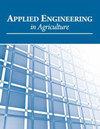常规和井下TDR土壤水分传感器在粘壤土灌溉调度中的现场评价
IF 0.9
4区 农林科学
Q4 AGRICULTURAL ENGINEERING
引用次数: 0
摘要
Acclima TDR-315™传感器获得的土壤剖面含水量近似于NMM测量结果。Campbell Scientific SoilVUE™10传感器的土壤剖面含水量严重低估了NMM的土壤剖面含水量。在所有深度,SoilVUE10传感器的VWC值始终小于TDR-315传感器报告的VWC值。这些发现不支持将SoilVUE10用于粘壤土的灌溉调度。摘要为了评估两种市售时域反射(TDR)土壤水分传感器在德克萨斯州布什兰(Bushland)附近的粘土壤土灌溉调度中的有效性,进行了一项实地研究。土壤vue10(坎贝尔科学公司,洛根,犹他州)和TDR-315 (Acclima公司,子午线,爱达荷州)传感器安装在中子水分计(NMM)通道管30厘米内的研究领域种植玉米(Zea mays L),并由中心枢轴洒水系统灌溉。灌溉处理包括50%、75%和100%的蒸散发(ET)替代,每个地块安装两个通道管,共6个传感器评估点。每半周测量一次,使用现场校准的NMM来监测整个生长季节的土壤水分状况和灌溉计划。利用安装在等效深度上的SoilVUE10和垂直分布的Acclima TDR-315传感器阵列获取地表至1.1 m深度范围内的土壤剖面含水量值,并与NMM数据进行比较。在50%、75%和100%处理下,TDR-315传感器测得的平均剖面土壤含水量与NMM测得的平均剖面土壤含水量呈良好趋势,平均偏置差(MBD)分别为-9.8、-3.1和8.4 mm。相比之下,在50%、75%和100%处理的MBD值分别为-54.4、-70.5和-89.8 mm的所有灌溉处理中,来自SoilVUE10传感器的土壤剖面含水量值严重低估了来自NMM的土壤剖面含水量值。对两种电磁传感器共有的9个深度的体积含水量(VWC)进行比较,结果表明,在所有灌溉处理中,SoilVUE10传感器的数值始终小于TDR-315。近地表(5厘米和10厘米深)的低估是由于土壤因电极接触而流失,这可能与灌溉后周期性干燥期间粘土收缩有关。虽然土壤与电极的接触在更深的深度可能会出现问题,但对于VWC的长期低估的解释不太明显,除了注意到安装后立即发生低估,这表明尽管使用了制造商的指南和工具,但安装后电极与土壤的接触很差。其他可能的原因包括精确估计土壤介电常数的挑战,包括塑料传感器体的测量介电常数。该研究结果表明,垂直分布的TDR-315传感器阵列可以提供足够的剖面含水量值,用于监测粘土壤土的土壤水分状况,以便进行灌溉调度。对SoilVUE10传感器观察到的长期低估不支持其用于水资源研究和灌溉管理,并可能导致过度灌溉。此外,相对较短的1 m长度小于许多区域作物的生根深度,因此无法确定根区以下的渗流。关键词:Acclima TDR-315, Campbell Scientific SoilVUE,灌溉调度,中子水分计,半干旱,土壤水分传感器,时域反射法,体积含水量本文章由计算机程序翻译,如有差异,请以英文原文为准。
Field Evaluation of Conventional and Downhole TDR Soil Water Sensors for Irrigation Scheduling in a Clay Loam Soil
Highlights Soil profile water content derived from Acclima TDR-315™ sensors approximated those from NMM measurements. Soil profile water content from Campbell Scientific SoilVUE™10 sensors grossly underestimated those from the NMM. VWC values from SoilVUE10 sensors were consistently less than those reported by the TDR-315 sensors at all depths. These findings do not support SoilVUE10 use for irrigation scheduling in clay loam soils. Abstract. A field study was performed to evaluate the efficacy of two commercially available time domain reflectometry (TDR) soil water sensors for irrigation scheduling in a clay loam soil near Bushland, Texas. SoilVUE10 (Campbell Scientific Inc., Logan, Utah) and TDR-315 (Acclima Inc., Meridian, Idaho) sensors were installed within 30 cm of neutron moisture meter (NMM) access tubes in a research field planted to corn (Zea mays L) in 2020 and irrigated by a center pivot sprinkler system. Irrigation treatments included 50%, 75%, and 100% of evapotranspiration (ET) replacement with two access tubes installed in each plot, totaling six sensor evaluation sites. Semiweekly measurements with a field-calibrated NMM were used to monitor soil water status and schedule irrigation throughout the growing season. Soil profile water content values integrated over the surface to 1.1-m depth range were derived from SoilVUE10 and vertically distributed arrays of Acclima TDR-315 sensors installed at equivalent depths and were compared with those from NMM data. Average profile soil water contents from the TDR-315 sensors trended well with those from the NMM having mean bias difference (MBD) values of -9.8, -3.1, and 8.4 mm for the 50%, 75%, and 100% treatments, respectively. In contrast, soil profile water content values from the SoilVUE10 sensors grossly underestimated those from the NMM for all irrigation treatments with MBD values of -54.4, -70.5, and -89.8 mm for the 50%, 75%, and 100% treatments, respectively. Comparisons of volumetric water content (VWC) at each of the nine depths common to both electromagnetic sensor types revealed that values from the SoilVUE10 sensors were consistently less than TDR-315 values for all irrigation treatments. Underestimation at the near surface (5 and 10 cm depths) was attributed to loss of soil to electrode contact possibly associated with clay shrinkage during periodic drying following irrigation. Although soil to electrode contact can be problematic at greater depths, the explanation for chronic underestimation of VWC was less obvious except to note that underestimation occurred immediately after installation, which indicated poor electrode-soil contact after installation despite use of manufacturer guidelines and tools. Other possible reasons include challenges for accurate estimation of soil permittivity for a measured permittivity that includes the plastic sensor body. Results from this study suggest vertically distributed arrays of TDR-315 sensors can provide profile water content values adequate for monitoring soil water status for irrigation scheduling in a clay loam soil. The chronic underestimation observed for the SoilVUE10 sensors does not support their use for water resources research and irrigation management and could lead to over irrigation. Additionally, the relatively short 1 m length is less than the rooting depth of many regional crops and thus not capable of determining percolation below the root zone. Keywords: Acclima TDR-315, Campbell Scientific SoilVUE, Irrigation scheduling, Neutron moisture meter, Semi-arid, Soil water sensors, Time domain reflectometry, Volumetric water content.
求助全文
通过发布文献求助,成功后即可免费获取论文全文。
去求助
来源期刊

Applied Engineering in Agriculture
农林科学-农业工程
CiteScore
1.80
自引率
11.10%
发文量
69
审稿时长
6 months
期刊介绍:
This peer-reviewed journal publishes applications of engineering and technology research that address agricultural, food, and biological systems problems. Submissions must include results of practical experiences, tests, or trials presented in a manner and style that will allow easy adaptation by others; results of reviews or studies of installations or applications with substantially new or significant information not readily available in other refereed publications; or a description of successful methods of techniques of education, outreach, or technology transfer.
 求助内容:
求助内容: 应助结果提醒方式:
应助结果提醒方式:


